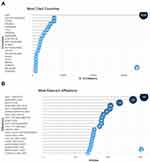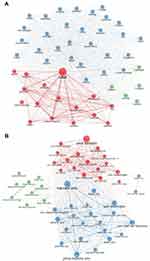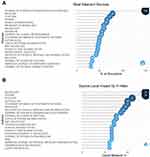Back to Journals » Journal of Pain Research » Volume 16
Bibliometric Analysis of Post-Stroke Pain Research Published from 2012 to 2021
Authors Xiong F, Shen P , Li Z, Huang Z, Liang Y, Chen X, Li Y , Chai X , Feng Z, Li M
Received 22 May 2022
Accepted for publication 12 December 2022
Published 5 January 2023 Volume 2023:16 Pages 1—20
DOI https://doi.org/10.2147/JPR.S375063
Checked for plagiarism Yes
Review by Single anonymous peer review
Peer reviewer comments 3
Editor who approved publication: Dr Jonathan Greenberg
Feng Xiong,1 Peng Shen,1 Zhenhui Li,2 Ziyi Huang,1 Ying Liang,1 Xiwen Chen,1 Yutong Li,3 Xinping Chai,3 Zhen Feng,1,* Moyi Li1,*
1Rehabilitation Medicine Department, The First Affiliated Hospital of Nanchang University, Nanchang, People’s Republic of China; 2Children Health Care Department, Longyan First Hospital Affiliated to Fujian Medical University, Longyan, People’s Republic of China; 3First School of Clinical Medicine, Nanchang University, Nanchang, People’s Republic of China
*These authors contributed equally to this work
Correspondence: Moyi Li; Zhen Feng, Rehabilitation Medicine Department, The First Affiliated Hospital of Nanchang University, No. 17, Yong Wai Zheng Jie, Nanchang, Jiangxi, 330006, People’s Republic of China, Tel +86 15806031050 ; +86 13970038111, Email [email protected]; [email protected]
Background and Purpose: Pain is one of the most common symptoms in patients after stroke. It is a distressing experience that affects patients’ quality of life, and it is highly prevalent in clinical practice. The pathogenesis mechanisms of PSP are not so clear, and there is currently a lack of effective medical treatments, hence it is necessary to establish a sufficient understanding of this disease. Limited number of studies have applied bibliometric methods to systematically analyze studies on post-stroke pain. This study aimed to systematically analyze scientific studies conducted worldwide on post-stroke pain from 2012 to 2021 to evaluate global trends in this field using a bibliometric analysis.
Methods: Publications related to post-stroke pain from 2012 to 2021 were obtained from the Web of Science Core Collection database. Bibliometrics Biblioshiny R-package software was used to analyze the relationship of publication year with country, institution, journals, authors, and keywords and to generate variant visual maps to show annual publications, most relevant countries, authors, sources, keywords, and top-cited articles.
Results: In this study, 5484 papers met the inclusion criteria. The annual growth rate of publications was 5.13%. The USA had the highest number of publications (1381, 25.2%) and citations (36,395), and the University of Toronto had the highest number of papers (156, 2.8%). “Stroke”, “management”, “pain”, “risk”, “prevalence”, “ischemic stroke”, “risk factors”, “disease”, “diagnosis” and “therapy” are the top 10 keywords.
Conclusion: The global research interest regarding PSP has maintained growing over the past ten years. Both central post stroke pain and hemiplegic shoulder pain are the hottest research subjects. Further investigations are needed in order to reveal the mystery of the pathophysiologic mechanisms of CPSP, and high-quality well-designed trials of potential treatments of CPSP and HSP are also needed.
Keywords: post-stroke pain, publication trends, bibliometric analysis, research interest
Introduction
Post-stroke pain (PSP) is a common and refractory disabling complication in stroke survivors. The mean prevalence of the various types of post-stroke pain was 29.56%, which was higher in the subacute and chronic stages than in the acute post-stroke stage (14.06% in the acute, 42.73% in the subacute, and 31.90% in the chronic post-stroke stage).1–3 The most common types of PSP include central post-stroke pain (CPSP), complex regional pain syndrome (CRPS), pain secondary to spasticity, shoulder pain, and headache.3–5 Currently, the diagnosis of definite neuropathic pain should be based on the sensory findings, relevant lesion, and specific findings on clinical examination, as there are no pathognomonic features of PSP.6–8 Patients who experience PSP seem to be more likely to have a lower quality of life, poorer cognitive and functional performance, higher fatigue perception, and higher incidence of depression, anxiety symptoms, sleep disorders, and suicidality, facing the dual challenges of physical and mental suffering.9–15 Both pharmacological and non-pharmacological interventions can be used to relieve PSP.16 Besides, a multimodal strategy incorporating lifestyle-related interventions have been studied to optimize prognosis with improved quality of life and social participation after stroke, considering the complex interrelation between medical and psychosocial aspects of post-stroke pain and other post-stroke complications.16
Bibliometrics is a comprehensive science mapping analysis tool for analyzing and processing massive literature information, improve the efficiency of scientific research.17 It is extensively used to visualize the citation, cooperation, co-occurrence and other relationships within the literatures, and construct various types of knowledge maps,17–19 and explore the critical paths, research hotspots, and frontiers of the evolution of this discipline or field.20 In the past 10 years, bibliometric analyses have been conducted on other stroke-related research hotspots, such as inflammasomes,21 traditional medicine,22 and rehabilitation treatment.23 They used bibliometric methods to objectively present the global trend of pathogenesis, treatments of stroke and to provide important information for relevant researchers.
The pathogenesis mechanisms of PSP are not so clear, and there is currently a lack of effective medical treatments, hence it is necessary to establish a sufficient understanding of this disease.5,24 Limited number of studies have used bibliometric methods to analyze the overall aspects pertaining to PSP currently. Therefore, this study aimed to methodically offer a comprehensive scientific analysis of published research within the past 10 years using a bibliometric analysis. The results of the present study would provide valuable reference information for researchers about identification of the current focus and challenges in the research evidence of post-stroke pain.
Materials and Methods
Source of Data and Search Strategy
We chose the WoSCC database as the source of data. The WoS was chosen because it consists of a wide conglomerate of quality and high-impact scientific studies, which is the most frequent database used for bibliometric study.25–27 A combination of controlled vocabulary (MeSH) and free text terms was used to search the database. The search strategy was as follows: TS = (apoplexy* OR “stroke”, OR “hemiplegia”, OR “cerebrovascular accident”) AND TS = (“pain”, OR pain* OR “ache”, OR ache*OR *ache). The publishing year was set from January 1, 2012 to December 31, 2021. We can analyze the development and changes in a field through ten years, which is the most frequent time span used for bibliometric study.27
Inclusion and Exclusion Criteria
Papers published between 2012 and 2021 were retrieved. Articles and reviews related to stroke and pain in different academic journals were included. We excluded proceedings papers, meeting abstracts, editorial materials, early access, letters, notes, book chapters, corrections, reprints, discussions, news items, retracted publications, biographical articles, retractions, and duplicate papers. The language was unrestricted, and species-specific restrictions were not specified. We identified 5694 documents from the WoSCC database. After excluding 210 articles, 5484 papers were included. The papers were filtered using the Web of Science (WoS) website and Bibliometrix Biblioshiny R-package software.
Bibliometric Analysis
We followed a previously defined search strategy to search through the WoSCC database and then imported these results to the Bibliometrix Biblioshiny R-package software (https://bibliometrix.org/Biblioshiny.html) for analysis.27,28 We analyzed the following: (1) distribution of countries, institutions, authors, and journals, (2) number of papers and H-index in the top 20 journals, (3) collaborations among countries/institutions/authors, and (4) keywords and the top 20 papers cited most frequently. Additionally, we visualized the structure, regular patterns, and distribution of scientific knowledge using Biblioshiny. The complete data acquisition process is illustrated in Figure 1.
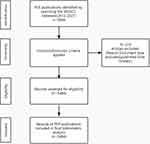 |
Figure 1 Flow chart for publications selection. |
Results
General Information on the Retrieved Documents
There were 4395 articles and 1089 review papers. All these documents use 10,223 keywords plus. Keywords plus are words or phrases that frequently appear in article reference titles and are generated automatically by a computer. There is a high collaboration in PSP publications that is shown by the collaboration index. Authors per document ratio is 5.26, which means, on average, almost five authors have written one document. Table 1 summarizes the preliminary information on the collected bibliometric data.
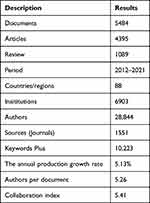 |
Table 1 Summary of the Main Information of Collected Bibliometric Data |
Countries and Institution Distribution
The 5484 papers on PSP were contributed by 88 countries/regions between 2012 and 2021 (Supplementary Table 1). The USA made the highest contribution to PSP research, having produced the highest number of papers (1381), followed by China (716), Italy (276), and Korea (265). Figure 2 gives a complete picture of the number of authors affiliated with the country of publication. The blue color intensity, in the figure, is proportional to the number of affiliated authors with each country. The USA, China, and Italy made the darkest blue. The top 20 countries or regions according to the number of citations are listed in Figure 3A, with the USA having the most significant number of citations (36,395), followed by the UK (7105), China (7026), and France (5914). Among 6903 institutions (Supplementary Table 2), the top 20 were listed according to number of publications, as shown in Figure 3B. The University of Toronto had the highest number of papers (156), followed by Harvard University (139), Mayo Clinic (118), and Harvard Medical School (104). The extensive cooperation among the countries is shown in Figures 4 and 5A. The link thickness was proportional to the number of joint publications within each country. Overall, the USA seemed to be the hub for any published document, as there were many scientific links between the USA and other countries.
 |
Figure 2 Country’s scientific production world map of post stroke pain research field (blue color intensity: the number of authors affiliated with each country, grey color: non-related country). |
 |
Figure 4 Social structure: Countries collaboration map. The thickness of connecting lines indicates the frequency of collaboration. |
The extensive cooperation among the institutions is shown in Figure 5B. The University of Toronto and Harvard University are the two leading scientific centers; they have extensive cooperation with other institutions.
Authors
The 5484 papers were contributed by 28,844 authors (Supplementary Table 3). The top 20 authors were ranked according to the number of publications (Figure 6A). Figure 6B shows the top 20 authors ranked by H-index. Zhang Y had the highest number of publications (25). Kurth T had the highest H-index value (12). In Figure 7, the top 20 countries are ranked according to the number of scientific publications. Red lines indicate the publication rate by the corresponding author’s country, wherein at least one foreign co-author exists, while blue lines represent the number of publications by authors from the same country. These are called multiple countries publication (MCP) and single country publication, respectively. The percentage of MCP indicated the status of international cooperation among the authors. The USA had the highest number of international collaboration, followed by China and the UK. Figure 8 shows the collaboration between the authors. Amongst the authors, Zhang Y not only has many cooperative relations with Wang Y but also has close cooperation with Li Y. There is also close cooperation between Ferrari MD, who ranks second in H-index, and Terwindt GM, who ranks third in H-index.
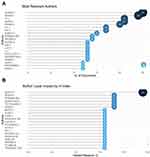 |
Figure 6 (A) Top 20 authors based on the number of publications. (B) Top 20 authors based on the number of H-index. |
 |
Figure 7 Top 20 corresponding author’s country based on the number of publications. (red line: Multiple Countries Publication (MCP), blue line, Single Country Publication (SCP)). |
Publication Outputs
In total, 5484 papers were included in the analysis. As shown in Figure 9A, the number of publications has been growing steadily over the last 10 years. The number of publications increased from 436 in 2012 to 717 in 2021. The annual growth rate was 5.13% as computed by Biblioshiny. The highest number of papers (717) was published in 2020. Figure 9B shows that the average number of article citations had a steady growth from 2013 to 2016, but started to fluctuate from 2017 to 2021, and tended to decline sharply from 2020 to 2021.
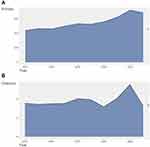 |
Figure 9 (A) Annual scientific growth of post stroke pain. (B) Average article citations per year of post stroke pain. |
Journals
The 5484 papers were published in 1551 academic journals, as shown in Supplementary Table 4. The top 20 journals were selected and recorded according to the number of papers, as shown in Figure 10A. The total number of published articles in the top 20 journals was approximately 20.3% of the total articles. The Journal of Stroke & Cerebrovascular Diseases, an academic journal with an impact factor (IF) and Quartile 2021 of 2.136/Q4, had the highest number of papers on PSP (150 publications, 2.7%), followed by Medicine (IF/Quartile 2021, 1.89/Q2; 78 publications; 1.4%), PLoS One (IF/Quartile 2021, 3.240/Q2; 72 publications; 1.3%), and Stroke (IF/Quartile 2021, 7.914/Q1; 66 publications; 1.2%). The academic journals Stroke and Neurology tied for the first place, as they had the highest H-index value, which reached 28, as shown in Figure 10B. Among the top 20 journals with the highest number of papers, 25% of them were in the first quartile (Q1) and 40% were in the second quartile (Q2), under the journal IF quartile of WoS.
Keywords
As shown in Figure 11, the top 10 keywords from the start of 2012 were analyzed using keywords plus. The most frequent keywords were “stroke” (n = 1044), “management” (n = 439), “pain” (n = 424), “risk” (n = 403), “prevalence” (n = 352), “ischemic stroke” (n = 290), “risk factors” (n = 290), “disease” (n = 286), “diagnosis” (n = 226), and “therapy” (n = 223). Figure 12 shows the top keywords used in the PSP field over the last 10 years. The font size or color of these words shows their importance. Figure 13 shows the themes in the PSP field on a thematic map. A thematic map helps to identify the important concepts within a field. It presents a visualization of the semantic strength of the themes’ internal (correlation between concepts) and external (cohesiveness of nodes) association, which are measured as density and centrality, respectively (Examining the developments in scheduling algorithms research: A bibliometric approach). In Figure 13, each bubble represents a keyword network cluster. The cluster name is the word with the highest existence rate. The bubble size is related to the cluster word occurrences, and its position depends on cluster centrality and density. The upper-right quadrant shows the motor themes, the lower-right quadrant shows the basic themes, the lower-left quadrant shows the emerging or disappearing themes, and the upper-left quadrant shows the developed themes less used and possibly understudied. Keywords, such as pain, therapy and quality-of-life, are called motor themes because of their high level of importance and improvement. Keywords, such as double-blind, brain, neuropathic pain are called niche themes because of their low level of importance and high level of improvement. Keywords, such as stroke, risk, and prevalence, are called basic and transversal themes because of their high level of importance and low level of improvement. Keywords, such as management, diagnosis, and outcomes, are called emerging or clinging themes because of their low level of importance and improvement. It is expected that the outcomes of this study will provide a better vision of future research directions.
 |
Figure 12 Most relevant keywords in post stroke pain research. The size of a keyword is determined by its frequency of occurrence in the entire dataset. |
Characteristics of the Top 100 Papers Cited Most Frequently
The 100-most highly cited articles are shown in Table 2. All 100 of these articles were published between 2012 and 2020. According to further analysis, among the top 100 papers, 25 was published in 2012, 15 was in 2013, 14 was in 2014, 22 was in 2015, 14 was published in 2016, 7 was in 2017, 3 was published in 2018, only 1 was in 2020. Therefore, we conclude that 2012~2015 was a fast-growing period in published research on PSP. The frequently used subjects in top-cited 100 articles include “Central post-stroke pain”, “poststroke hemiplegic shoulder pain”, “thalamus”, “ischemic stroke”. “Central post-stroke pain” and “poststroke hemiplegic shoulder pain” is a most frequent research subject, they has been occurred in 19 and 17 articles, respectively.
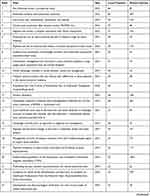 | 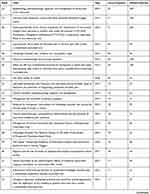 | 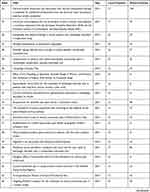 | 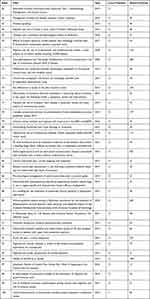 |
Table 2 Top 100 Articles with Their Local Citations and Global Citations |
Discussion
Global Potential and Achievement
Biblioshiny is a method used to manage and visualize knowledge structures. We conducted a novel bibliometric analysis via Biblioshiny on studies investigating PSP over the past decade to comprehensively view global research trends. Our bibliometric analysis revealed increased publications and changes in the contributions of journals, authors, countries, and institutions to this field.
The number of publications and citations in a field can reflect the productivity and development of the subject over time. Our results showed that the output of publications on PSP maintained a steady growth from 2012 to 2021 (Figure 9A). This overall growth trend in the number of related publications indicated that many scientists were investigating PSP. According to the citation analysis (Figure 9B), there was a steady growth in the average article citations per year from 2013 to 2016, but with fluctuating changes from 2017 to 2021, especially a sharp decline from 2020 to 2021. These citation counts are assumed to reflect the quality of an article and its relevance to research and/or clinical practice.29 Indeed, older publications inevitably received more citations than recent papers regardless of their impact. This is because newer articles tend to be cited less in their initial years of publication and also because there is shorter span of time to generate citation rates. So this might be one of the reasons for the sharp decline of citations from 2020 to 2021. Delays in reporting, dissemination, and uptake of research evidence as well as embargo periods, may all affect citation frequency. The trend of the present study revealed that in the last 2 years, the average article citations per year decreased; however, it is too early to predict whether these publications will be cited more often over time.
Popular core journals can provide a reliable reference for researchers searching for documents and publishing their work. Among the journals in which PSP-related articles were published, the Journal of Stroke & Cerebrovascular Diseases has published the most articles, while Stroke and Neurology tied for the first place in the H-index. In terms of publications and citations, the most influential journal was Stroke, which, despite ranking fourth in publication, stood first in terms of the H-index.
Identifying the countries or institutions that have contributed the most may guide researchers in pursuing advanced studies and seeking cooperation. According to the number of published papers (Figure 2), the USA, China, Italy, and Korea were the countries that contributed the most to investigating PSP. According to institutional productions, the University of Toronto contributed the most among the institutions (Figure 3B). Among the top 20 institutions, nine were from the US, four from China, two from Canada, one from Sweden, one from Denmark, one from South Korea, one from Brazil, and one from Iran. By analyzing the network map of the cooperation among the countries/institutions, we can easily acknowledge that there are many scientific links between the USA and other countries. Additionally, the USA has, by far, the highest MCP. These results indicate that the USA was the supreme power in this field and at the forefront in this field of research.
Research Energy and Potential
Keywords tend to provide the main focus of papers and reflect the most popular current and future research topics. We can obtain relevant information about hotspots in the PSP research field based on keyword analysis. Bibliometric analysis revealed the main keywords of papers in the PSP research field over the last 10 years. In the last 10 years, the top 10 keywords on PSP included “stroke”, “management”, “pain”, “risk”, “prevalence”, “ischemic stroke”, “risk factors”, “disease”, “diagnosis” and “therapy”, as shown in Figure 11. Since our search strategy included “stroke” and “pain”, the keywords “stroke” and “pain” were used most frequently. A large cohort with ischemic stroke suggested that chronic pain syndromes are common after ischemic stroke.10 Management, risk factors, diagnosis and therapy occupied pivotal positions in this field, indicating that clinical practice studies were of vital importance for PSP research.
Generally, a top-cited publication could provide a good view for scholars who want to acquire quick insight in a particular field. In order to obtain more information about post stroke pain in a more effective way, we do further literature reading and analysis on the 100 top cited papers which were published between 2012 and 2020.
As shown in result section, central post-stroke pain and hemiplegic shoulder pain were chosen as important frontier topics in our study.
(1) In earlier studies, CPSP was described as one of the definitive symptoms of thalamic lesion.30 However, more recent studies suggest that it is not only seen after thalamic lesions but also seen after vascular lesions in any part of the central nervous system.30 There are certain hypotheses to explain physiopathologic mechanisms of CPSP, including dissociated sensory loss and central sensitization.8,31 Oral medications and non-drug treatments are used for the management of CPSP.30,32 Oral medications include antidepressants (tricyclic antidepressants, selective serotonin-norepinephrine reuptake inhibitors), antiepileptic drugs (carbamazepine, lamotrigine, gabapentin), opioids.30 Non-drug treatments include neuromodulation, mirror therapy and immersive virtual reality interventions.30 Studies suggested that these non-drug treatments like neuromodulation, mirror therapy and immersive virtual reality interventions got benefits in improving central post stroke pain symptoms, and might be a promising intervention for the management of CPSP.33–35 Large randomized trials of good quality trials are needed in the future.36 Investigators should mount more high-quality trials on pathysiopathologic mechanisms and treatments of CPSP in the future. Revealing the underlying pathophysiologic mechanisms of CPSP will definitely help the physician to better understand the disease and will shed light for better treatment options.
(2) Hemiplegic shoulder pain (HSP) is a common complication of stroke, whose prevalence was ranging from 22 to 47%.37 It may result in a significant loss of function and detriment to quality of life. From 2012 to 2015, many studies have suggested that the pathogenesis of HSP is multifactorial and includes neurologic and mechanical factors, often in combination.38–41 Neurologic factors include paralysis, spasticity, central poststroke pain, central sensitization, peripheral neuropathy, brachial plexus injury, complex regional pain syndrome.38 Mechanical Factors include shoulder subluxation, rotator cuff injury, glenohumeral joint disorders, adhesive capsulitis, myofascial pain, direct trauma.38 Management of HSP remains challenging. Numerous treatment methods have been suggested, such as botulinum toxin type A, suprascapular nerve block, subacromial corticosteroid injection, shoulder taping and peripheral nerve stimulation, but evidence for these treatments remains insufficient42–46.
A more recent study named “Effects of Kinesio taping for stroke patients with hemiplegic shoulder pain: A double-blind, randomized, placebo-controlled study” published in 2017 suggested that Kinesio taping may be an alternative treatment option for stroke patients with hemiplegic shoulder pain.47 Studies with larger sample sizes and longer follow-up periods on Kinesio taping are recommended in the future. As pain is known to affect our daily activities and quality of sleep, it can have a major role on quality of life and rehabilitation outcome.47 Most studies focus on their pain status and function outcomes of patients with hemiplegic shoulder pain among these 100 top cited papers. While there are only two studies have paid attention to their quality of life since 2016.47,48 We suggested that more high-quality studies should focus on the quality of life in hemiplegic shoulder pain patients in the future.
Strengths and Limitations
This study has some limitations. For instance, we selected only the WoSCC database for the retrieval of articles, some publications in other databases might have been missed. Furthermore, despite performing a bibliometric analysis, we did not conduct methodological quality assessments of the included papers. Notably, an article with a high citation count does not imply that it has high quality. Citation can be affected by factors that are irrelevant to the value of articles. Third, there is an inherent prejudice of bibliometrics against recently published articles or papers which might lead to some extremely vital papers not being involved or included in such analysis as it takes time to amass citations. Newer articles often show less representation in the list of top 100 articles. Bibliometric investigation on newly published high-quality articles would be overlooked or ignored. This is a drawback connected to the effect of the number of times cited. Hence, more robust methods of qualitative assessment such as methodological analysis could be combined with bibliometric parameters to give a more holistic insight into the research dynamics of a field in the future.
Conclusions
This study provides knowledge on post stroke pain from a visualization and bibliometric perspective. The results of this study showed that the global research interest regarding post stroke pain has maintain growing over the past ten years from the growing trend of publications on this topic. Both central post stroke pain and hemiplegic shoulder pain are the hottest research subjects. There are some unresolved problems about these field. Future research should focus on high-quality well-designed trials of pathophysiologic mechanisms and potential treatments of central post stroke pain. As for managements of hemiplegic shoulder pain, improving quality of life is important as treating pain status and function outcomes. On the one hand, more effort should be directed towards high-quality well-designed trials of potential treatments, on the other hand, future researchers should pay more attention to the quality of life in hemiplegic shoulder pain patients.
Acknowledgments
This work was supported by Science and Technology Department of Jiangxi Province (No. 20202BABL216063).
Disclosure
The authors declare that there is no conflict of interest regarding the publication of this paper.
References
1. Paolucci S, Iosa M, Toni D, et al. Prevalence and time course of post-stroke pain: a multicenter prospective hospital-based study. Pain Med. 2016;17:924–930. doi:10.1093/pm/pnv019
2. Paolucci S, Martinuzzi A, Scivoletto G, et al. Assessing and treating pain associated with stroke, multiple sclerosis, cerebral palsy, spinal cord injury and spasticity. Evidence and recommendations from the Italian consensus conference on pain in neurorehabilitation. Eur J Phys Rehabil Med. 2016;52:827–840.
3. Harrison RA, Field TS. Post stroke pain: identification, assessment, and therapy. Cerebrovasc Dis. 2015;39:190–201. doi:10.1159/000375397
4. Scuteri D, Mantovani E, Tamburin S, et al. Opioids in post-stroke pain: a systematic review and meta-analysis. Front Pharmacol. 2020;11:587050. doi:10.3389/fphar.2020.587050
5. Delpont B, Blanc C, Osseby GV, Hervieu-Bègue M, Giroud M, Neurologique YBJR. Pain after stroke: a review. Rev Neurol. 2018;174:S0035378717306586. doi:10.1016/j.neurol.2017.11.011
6. Choi HR, Aktas A, Bottros MM. Pharmacotherapy to manage central post-stroke pain. CNS Drugs. 2021;35:151–160. doi:10.1007/s40263-021-00791-3
7. Garcia-Larrea L, Hagiwara K. Electrophysiology in diagnosis and management of neuropathic pain. Rev Neurol. 2019;175:26–37. doi:10.1016/j.neurol.2018.09.015
8. Klit H, Finnerup NB, Jensen TS. Central post-stroke pain: clinical characteristics, pathophysiology, and management. Lancet Neurol. 2009;8:857–868. doi:10.1016/S1474-4422(09)70176-0
9. Gandolfi M, Donisi V, Battista S, et al. Health-related quality of life and psychological features in post-stroke patients with chronic pain: a cross-sectional study in the neuro-rehabilitation context of care. Int J Environ Res Public Health. 2021;18:3089. doi:10.3390/ijerph18063089
10. O’Donnell MJ, Diener HC, Sacco RL, et al. Chronic pain syndromes after ischemic stroke: profess trial. Stroke. 2013;44:1238–1243. doi:10.1161/STROKEAHA.111.671008
11. Naess H, Lunde L, Brogger J. The triad of pain, fatigue and depression in ischemic stroke patients: the Bergen stroke study. Cerebrovasc Dis. 2012;33:461–465. doi:10.1159/000336760
12. Naess H, Lunde L, Brogger J, Waje-Andreassen U. Fatigue among stroke patients on long-term follow-up. The Bergen stroke study. J Neurol Sci. 2012;312:138–141. doi:10.1016/j.jns.2011.08.002
13. White JH, Attia J, Sturm J, Carter G, Magin P. Predictors of depression and anxiety in community dwelling stroke survivors: a cohort study. Disabil Rehabil. 2014;36:1975–1982. doi:10.3109/09638288.2014.884172
14. Khazaal W, Taliani M, Boutros C, et al. Psychological complications at 3 months following stroke: prevalence and correlates among stroke survivors in Lebanon. Front Psychol. 2021;12:663267. doi:10.3389/fpsyg.2021.663267
15. Tang WK, Liang H, Mok V, Ungvari GS, Wong KS. Is pain associated with suicidality in stroke? Arch Phys Med Rehabil. 2013;94:863–866. doi:10.1016/j.apmr.2012.11.044
16. Plecash AR, Chebini A, Ip A, et al. Updates in the treatment of post-stroke pain. Curr Neurol Neurosci Rep. 2019;19:86. doi:10.1007/s11910-019-1003-2
17. Aria M, Cuccurullo C. Bibliometrix: an r-tool for comprehensive science mapping analysis. J Informetr. 2017;11:959–975. doi:10.1016/j.joi.2017.08.007
18. Ale Ebrahim S, Ashtari A, Zamani Pedram M, Ale Ebrahim N, Sanati-Nezhad A. Publication trends in exosomes nanoparticles for cancer detection. Int J Nanomedicine. 2020;15:4453–4470. doi:10.2147/IJN.S247210
19. Kalantari A, Kamsin A, Kamaruddin HS, Ebrahim NA, Shamshirband SJ. A bibliometric approach to tracking big data research trends. J Big Data. 2017;4:30. doi:10.1186/s40537-017-0088-1
20. Chen C, Song M. Visualizing a field of research: a methodology of systematic scientometric reviews. PLoS One. 2019;14:e0223994. doi:10.1371/journal.pone.0223994
21. Yin J, Wan J, Zhu J, Zhou G, Pan Y, Zhou H. Global trends and prospects about inflammasomes in stroke: a bibliometric analysis. Chin Med. 2021;16:53. doi:10.1186/s13020-021-00464-9
22. Huang L, Shi X, Zhang N, et al. Bibliometric analysis of trends and issues in traditional medicine for stroke research: 2004–2018. BMC Complement Med Ther. 2020;20:39. doi:10.1186/s12906-020-2832-x
23. Feng X, Liu C, Guo Q, et al. Research progress in rehabilitation treatment of stroke patients: a bibliometric analysis. Neural Regen Res. 2013;8:1423–1430. doi:10.3969/j.issn.1673-5374.2013.15.010
24. Treister AK, Hatch MN, Cramer SC, Chang EY; Function RtJoI, Rehabilitation. Demystifying poststroke pain: from etiology to treatment. PM R. 2016;9:63. doi:10.1016/j.pmrj.2016.05.015
25. Chen B, Shin S. Bibliometric analysis on research trend of accidental falls in older adults by using citespace-focused on web of science core collection (2010–2020). Int J Environ Res Public Health. 2021;18:1663.
26. Chen D, Zhang G, Wang J, et al. Mapping trends in moyamoya angiopathy research: a 10-year bibliometric and visualization-based analyses of the web of science core collection (woscc). Front Neurol. 2021;12:637310. doi:10.3389/fneur.2021.637310
27. Igwaran A, Edoamodu CE. Bibliometric analysis on tuberculosis and tuberculosis-related research trends in Africa: a decade-long study. Antibiotics. 2021;10. doi:10.3390/antibiotics10040423
28. Jiang CM, Duangthip D, Chan AKY, Tamrakar M, Lo ECM, Chu CH. Global research interest regarding silver diamine fluoride in dentistry: a bibliometric analysis. J Dent. 2021;113:103778. doi:10.1016/j.jdent.2021.103778
29. Khan AS, Ur Rehman S, Ahmad S, AlMaimouni YK, Alzamil MAS, Dummer PMH. Five decades of the international endodontic journal: bibliometric overview 1967–2020. Int Endod J. 2021;54:1819–1839. doi:10.1111/iej.13595
30. Akyuz G, Kuru P. Systematic review of central post stroke pain: what is happening in the central nervous system? Am J Phys Med Rehabil. 2016;95:618–627. doi:10.1097/PHM.0000000000000542
31. Kalita J, Kumar B, Misra UK, Pradhan PK. Central post stroke pain: clinical, MRI, and SPECT correlation. Pain Med. 2011;12:282–288. doi:10.1111/j.1526-4637.2010.01046.x
32. Mulla SM, Wang L, Khokhar R, et al. Management of central poststroke pain: systematic review of randomized controlled trials. Stroke. 2015;46:2853–2860. doi:10.1161/STROKEAHA.115.010259
33. Castelnuovo G, Giusti EM, Manzoni GM, et al. Psychological treatments and psychotherapies in the neurorehabilitation of pain: evidences and recommendations from the Italian consensus conference on pain in neurorehabilitation. Front Psychol. 2016;7:115. doi:10.3389/fpsyg.2016.00115
34. Rodriguez S, Badia S, Duff A, et al. Effects of virtual reality upper limb based training (rehabilitation gaming system) on spasticity, shoulder pain, and depression after stroke. Pm&r. 2011;3:S160–S160. doi:10.1016/j.pmrj.2011.08.013
35. Thieme H, Mehrholz J, Pohl M, Behrens J, Dohle C. Mirror therapy for improving motor function after stroke. Stroke. 2013;44:e1–2. doi:10.1161/STROKEAHA.112.673087
36. Liampas A, Velidakis N, Georgiou T, et al. Prevalence and management challenges in central post-stroke neuropathic pain: a systematic review and meta-analysis. Adv Ther. 2020;37:3278–3291. doi:10.1007/s12325-020-01388-w
37. Anwer S, Alghadir A. Incidence, prevalence, and risk factors of hemiplegic shoulder pain: a systematic review. Int J Environ Res Public Health. 2020;18:17. doi:10.3390/ijerph18010017
38. Vasudevan JM, Browne BJ. Hemiplegic shoulder pain: an approach to diagnosis and management. Phys Med Rehabil Clin N Am. 2014;25:411–437. doi:10.1016/j.pmr.2014.01.010
39. Zeilig G, Rivel M, Weingarden H, Gaidoukov E, Defrin R. Hemiplegic shoulder pain: evidence of a neuropathic origin. Pain. 2013;154:263–271. doi:10.1016/j.pain.2012.10.026
40. Wilson RD, Chae J. Hemiplegic shoulder pain. Phys Med Rehabil Clin N Am. 2015;26:641–655. doi:10.1016/j.pmr.2015.06.007
41. Kim YH, Jung SJ, Yang EJ, Paik NJ. Clinical and sonographic risk factors for hemiplegic shoulder pain: a longitudinal observational study. J Rehabil Med. 2014;46:81–87. doi:10.2340/16501977-1238
42. Marciniak CM, Harvey RL, Gagnon CM, et al. Does botulinum toxin type a decrease pain and lessen disability in hemiplegic survivors of stroke with shoulder pain and spasticity?: a randomized, double-blind, placebo-controlled trial. Am J Phys Med Rehabil. 2012;91:1007–1019. doi:10.1097/PHM.0b013e31826ecb02
43. Adey-Wakeling Z, Crotty M, Shanahan EM. Suprascapular nerve block for shoulder pain in the first year after stroke: a randomized controlled trial. Stroke. 2013;44:3136–3141. doi:10.1161/STROKEAHA.113.002471
44. Rah UW, Yoon SH, Moon DJ, et al. Subacromial corticosteroid injection on poststroke hemiplegic shoulder pain: a randomized, triple-blind, placebo-controlled trial. Arch Phys Med Rehabil. 2012;93:949–956. doi:10.1016/j.apmr.2012.02.002
45. Pandian JD, Kaur P, Arora R, et al. Shoulder taping reduces injury and pain in stroke patients: randomized controlled trial. Neurology. 2013;80:528–532. doi:10.1212/WNL.0b013e318281550e
46. Wilson RD, Gunzler DD, Bennett ME, Chae J. Peripheral nerve stimulation compared with usual care for pain relief of hemiplegic shoulder pain: a randomized controlled trial. Am J Phys Med Rehabil. 2014;93:17–28. doi:10.1097/PHM.0000000000000011
47. Huang YC, Chang KH, Liou TH, Cheng CW, Lin LF, Huang SW. Effects of kinesio taping for stroke patients with hemiplegic shoulder pain: a double-blind, randomized, placebo-controlled study. J Rehabil Med. 2017;49:208–215. doi:10.2340/16501977-2197
48. Adey-Wakeling Z, Liu E, Crotty M, et al. Hemiplegic shoulder pain reduces quality of life after acute stroke: a prospective population-based study. Am J Phys Med Rehabil. 2016;95:758–763. doi:10.1097/PHM.0000000000000496
 © 2023 The Author(s). This work is published and licensed by Dove Medical Press Limited. The full terms of this license are available at https://www.dovepress.com/terms.php and incorporate the Creative Commons Attribution - Non Commercial (unported, v3.0) License.
By accessing the work you hereby accept the Terms. Non-commercial uses of the work are permitted without any further permission from Dove Medical Press Limited, provided the work is properly attributed. For permission for commercial use of this work, please see paragraphs 4.2 and 5 of our Terms.
© 2023 The Author(s). This work is published and licensed by Dove Medical Press Limited. The full terms of this license are available at https://www.dovepress.com/terms.php and incorporate the Creative Commons Attribution - Non Commercial (unported, v3.0) License.
By accessing the work you hereby accept the Terms. Non-commercial uses of the work are permitted without any further permission from Dove Medical Press Limited, provided the work is properly attributed. For permission for commercial use of this work, please see paragraphs 4.2 and 5 of our Terms.

